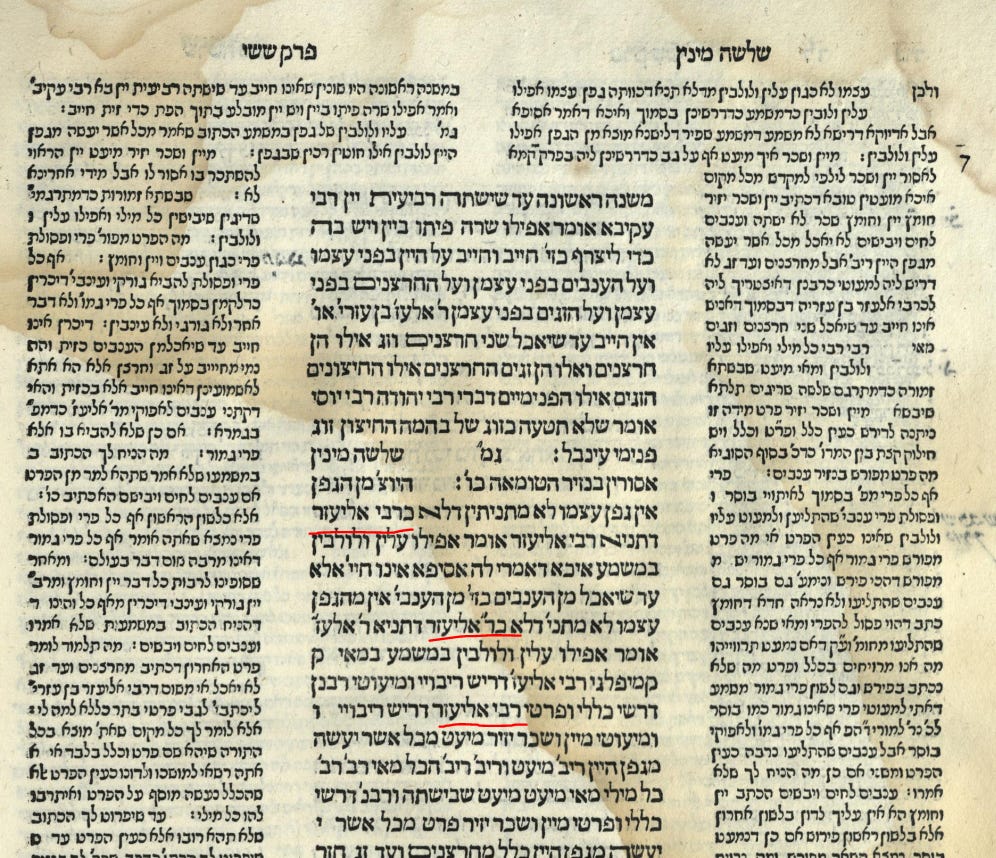After a Mishnah had listed the three things a nazir is prohibited in engaging in, and there was a Mishnah Rishona vs. Acharona, the gemara considers the authorship of the beginning of the Mishnah, or at least in accordance with whom it is stated. Thus on today’s daf, Nazir 34b:
שְׁלֹשָׁה מִינִין אֲסוּרִין בַּנָּזִיר: הַטּוּמְאָה כּוּ׳. הַיּוֹצֵא מִן הַגֶּפֶן — אִין. גֶּפֶן עַצְמוֹ — לָא. מַתְנִיתִין דְּלָא כְּרַבִּי אֶלְעָזָר. דְּתַנְיָא, רַבִּי אֶלְעָזָר אוֹמֵר: אֲפִילּוּ עָלִין וְלוּלָבִין בַּמַּשְׁמָע.
GEMARA: The mishna taught that three types of actions are prohibited for a nazirite: Contracting ritual impurity, shaving, and consuming products of the vine. The Gemara infers: That which emerges from the vine, yes, it is included in the prohibition; however, any part of the vine itself, other than its fruit, no, this is not forbidden. The Gemara comments: The mishna is not in accordance with the opinion of Rabbi Elazar. This is as it is taught in a baraita that Rabbi Elazar says: Even the leaves and tendrils of the vine are included in the prohibitions of naziriteship.
This is how Steinsaltz, Koren and Artscroll all have it. Now stam Rabbi Eleazar as a Tanna is Rabbi Eleazar ben Shamua, the fifth-generation Tanna.
However, just coming to point out that this all seems without merit. The Vilna Shas has ר”א throughout, and they have all expanded that to Rabbi Eleazar:
However, look at at the earlier Venice printing (which the Vilna printing contracted the name from) and it is spelled out as Rabbi Eliezer.
This would be Rabbi Eliezer ben Hyrcanus, third-generation Tanna. So too in Hachi Garsinan’s two manuscripts. Munich 95 has Rabbi Eliezer throughout:
and Vatican 110 as well.
Getting this right can have global repercussions, given that they are ascribing to this ר”א darshening ribuy and miut, as opposed to klal ufrat uchlat. Just something to keep in mind, and a reminder not to blindly trust the spelled out names.
As an exercise to the reader. Check out how the gemara lists it, and how various meforshim cite or discuss this Tanna, on Nazir 35a.
כְּדֶרֶךְ שֶׁפָּרַט לְךָ בְּנָזִיר ״מֵחַרְצַנִּים וְעַד זָג״. וּלְרַבִּי אֶלְעָזָר בֶּן עֲזַרְיָה דְּקָא מוֹקֵים לְהַאי ״מֵחַרְצַנִּים וְעַד זָג״ לוֹמַר שֶׁאֵינוֹ חַיָּיב עַד שֶׁיֹּאכַל שְׁנֵי חַרְצַנִּים וְזַג, פְּרָטָא מְנָא לֵיהּ! סָבַר לַהּ כְּרַבִּי אֶלְעָזָר דְּדָרֵישׁ מִיעֵט וְרִיבָּה.
in the manner that it specified with regard to a nazirite: “From pits to grape skin” (Numbers 6:4). The Gemara asks: And according to the opinion of Rabbi Elazar ben Azarya, who establishes this verse: “From pits to grape skin” (Numbers 6:4), as serving to say that a nazirite is liable only if he eats two grape seeds and a grape skin, if so from where does he derive the detail? It is unclear how he applies this method of a detail, a generalization, and a detail, as according to his interpretation, the phrase “from pits to grape skin” does not serve to limit the previous generalization but to state a different halakha. The Gemara answers: Rabbi Elazar ben Azarya holds in accordance with the opinion of Rabbi Elazar, who interprets this by saying that a verse restricts and amplifies.
See how the Vilna Shas has it (an explicit Rabbi Eleazar, against Venice and the two manuscripts with explicit Rabbi Eliezer), how Tosafot at Sefaria as printed has it, the Shita Mekubetzet cites it, and finally, how Tosafot is printed differently between the Vilna Shas and Venice Shas.
It was likely the later explicit instance of Rabbi Eleazar that misled the Steinsaltz and Artscroll versions to expand in this manner. And this also demonstrates the value of exploring how gemaras are cited in Rishonim, but also that you may have to look in variants of those Rishonim.





